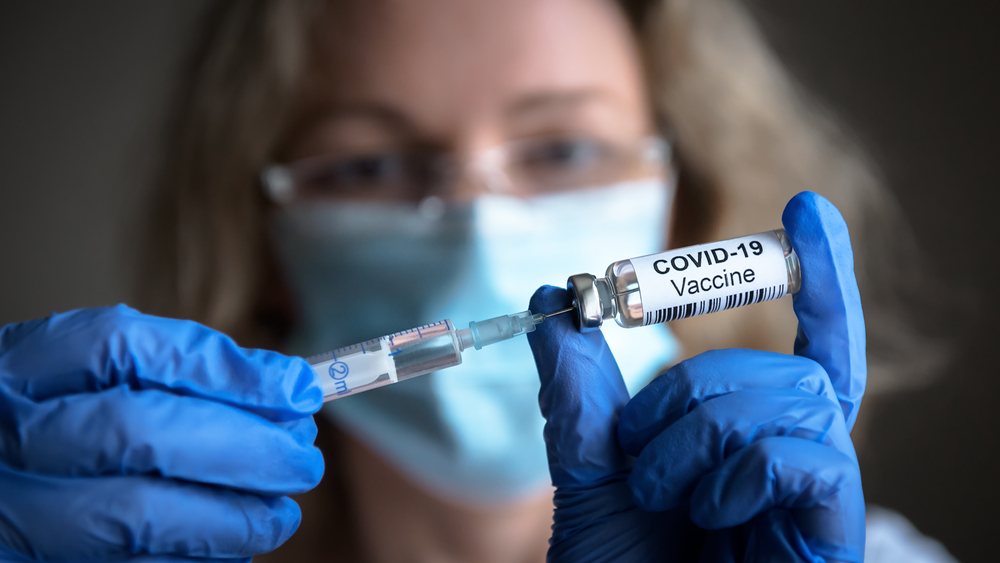Health authorities need to carefully consider the best COVID-19 vaccination strategy moving forward to protect Australians, write Dr Gary Grohmann and Professor Robert Booy.
Every few months, for the past two years, a new subvariant of the Omicron strain has emerged, with many new mutations, especially in the S protein (here). There is then a brief surge in transmission with a new peak of disease, although each new peak has usually been smaller than the peak before in both number and case fatality rate. It is time to stop catastrophising; most people now have immunity to severe disease from vaccination and/or wild viral infections.
Two recent recommendations from the World Health Organization (WHO) will have an important influence on Australia’s evolving response to the coronavirus disease 2019 (COVID-19) pandemic. The way Australia authorities react to these decisions will affect the lives of thousands of Australians.
Severe acute respiratory syndrome coronavirus 2 (SARS-CoV-2), the virus that causes COVID-19, has been economically and socially devastating (here). In the span of a few years, it has caused at least 770 million cases (likely over 1 billion) and more than 6.9 million deaths globally, and more than 11.6 million cases and 23 000 deaths in Australia, as of 8 November 2023.
Vaccination coverage plateaued in 2023, partly from many people achieving immunity to severe disease, from vaccine fatigue, and from some public distrust of the safety of novel platforms such as mRNA and viral-vectored COVID-19 vaccines (both extensively used in Australia). Necessarily, none of the initial COVID-19 vaccines used in Australia came with a history of long term safety data or had been used en masse in humans before the pandemic hit.

WHO recommendation 1: the end of the global health emergency
In May 2023, the WHO declared that the COVID-19 global health emergency is over (here and here). The WHO pointed to the dramatic drop in the global death rate of COVID-19 from 100 000 per week in January 2021 to 3500 per week in April 2023 as one of the reasons for its decision. Recently, Australia’s Chief Medical officer concurred: “While COVID-19 remains a serious threat to the health of Australians … COVID-19 it is no longer a Communicable Disease Incident of National Significance”.
Data show that the recent Omicron variants are causing less severe disease than previous subvariants, and although we are seeing new subvariants arise, at this time, we are no longer seeing regular large variations (new variants) such as when Delta mutated to Omicron. Omicron and its subvariants are still dominating (here), but generally causing milder disease as well as asymptomatic infection, while community immunity is improving from the combination of vaccination and natural infection — known as hybrid immunity.
The WHO has made it clear that although the emergency designation has ended, the COVID-19 pandemic still exists. We should not let down our guard or dismantle effective systems built to cope with the pandemic. For Australia, getting our vaccination strategy right will be crucial. The COVID-19 pandemic will not end soon.
WHO recommendation 2: the shift back to monovalent vaccines
Monovalent COVID-19 vaccines target a single variant of SARS-CoV-2, and bivalent vaccines provide protection against two different variants in a single vaccine formulation. The Australian Technical Advisory Group on Immunisation (ATAGI) originally recommended bivalent vaccines to provide broader protection from the virus. As such, up to now, some Australian COVID-19 vaccines have been bivalent, including an iteration of Omicron and an ancestral strain (Delta/Wuhan/Omicron BA.4/5.). However, the WHO has issued a new recommendation that future vaccination programs use monovalent vaccines instead. So, why the change?
The WHO provides several reasons for this new direction. Firstly, data show that the pre-Omicron variants no longer circulate, so the benefit of having an ancestral variant in the vaccine is limited. Secondly, there is evidence that inclusion of the ancestral variant may reduce the response to current variants due to immune imprinting — where the immune system’s response towards previously encountered antigens (ancestral variant) reduces the response to new antigens.
In the United States, all vaccines administered are monovalent vaccines of one subtype — XBB.1.5 (here). Consequently, the most significant point of differentiation between vaccines is now their vaccine platform, whether it is viral-vectored, recombinant protein, or mRNA (here and here). ATAGI has recently announced that it will follow the lead of the US in making a monovalent recommendation.
Australia’s vaccination program
It’s important that everyone aged 75 years and older and those in high risk groups are vaccinated and get boosted every six months (here), and also that vulnerable people (eg, those with complex needs or immunosuppression) take sensible precautions, especially in closed or poorly ventilated spaces. High risk groups will gain the most from receiving a COVID-19 booster.
Vaccines for the vulnerable, mask use in crowds, sensible social distancing, hygiene measures, as well as continuing education programs are still important in our post-pandemic response.
What about those not in a risk group, people with no obvious risk factors, and those aged under 75 years? Should they receive a booster? Advisory groups such as ATAGI make it clear (here) that healthy people aged under 18 years should not receive a booster, and healthy adults aged 18–74 years should consider receiving a booster but it is not specifically recommended. Vaccination should be seriously considered for travellers, pregnant women, and health care workers.
With Omicron and its subvariants still dominating and causing milder disease as well as asymptomatic infection, community immunity is improving from the combination of vaccination and natural infection (hybrid immunity). However, it is still very important for people in high risk groups including older adults and people with immune problems get regular booster vaccines every six months.
Choice of vaccination platform
mRNA vaccines, viral-vectored vaccines, and recombinant protein vaccines have demonstrated impressive efficacy and safety, allowing regulators around the world to grant provisional or emergency use registration while further data collection is underway. More than 13.5 billion vaccine doses have been administered globally using various platforms in different countries.
Although the mRNA COVID-19 vaccine is the preferred choice of ATAGI, protein-based vaccines options offer advantages and can be used as a booster if preferred by the patient. TGA-approved recombinant protein technology has a strong safety record (here), good protective efficacy in high risk populations, is a monovalent formulation and is more suited to efficient cold-chain storage and distribution.
Protein-based recombinant vaccines have also exhibited lower rates of myocarditis/pericarditis compared with background cases globally but more evidence from quality surveillance is necessary before conclusions can be drawn (here). In addition, anecdotal reports indicate that protein vaccines may result in fewer workdays missed compared with mRNA vaccines.
Given the current understanding of the enhanced protection provided by heterologous vaccination, which involves administering different vaccine types, it is our opinion that protein vaccines should also be considered for booster shots for individuals who have completed their primary vaccination series. Moreover, protein vaccines have greater thermostability compared with mRNA vaccines and are thus more safely distributed via a straightforward cold chain.
What’s next for Australia?
Australia has done well in containing the COVID-19 pandemic through non-pharmaceutical interventions and in being successful with high vaccination rates (here). However, the COVID-19 pandemic is still here, and health authorities need to carefully consider the best vaccination strategy moving forward to protect Australians. With the recent WHO recommendations, a large part of this will involve analysing data from the United States, and other northern hemisphere countries, as they continue to vaccinate during their upcoming winter. Timely surveillance and genetic sequence data tracking of viral evolution will be essential to inform our response.
Other challenges involve the management of post-COVID-19 condition (“long COVID”), vaccine injury, and vaccine fatigue, with better use of antiviral drugs such as molnupiravir and paxlovid, as well as the use of antibody therapy (passive immunisation) especially for risk groups. The spread of disinformation also needs to be monitored and countered. The advent of mRNA vaccines against SARS-CoV-2 has been fortuitous, but significant work must continue with antiviral drugs and antibody therapy as these should be more immediately available to counter the next pandemic, whether it is influenza, a coronavirus or another respiratory virus.
The current government review of our COVID-19 response, by three experts, will inform the response to the next pandemic. It must also include a review of decisions taken both federally and by all the states and territories of Australia — senior members of the “war cabinet”, Prime Ministers and Premiers must be exposed to scrutiny of decisions taken for public health, administrative and economic purposes.
Gary Grohmann is former Director of Immunobiology and WHO Essential Regulatory Laboratory at the Therapeutic Goods Administration. He currently works as an independent consultant, primarily with the WHO on influenza-related projects in the Global Influenza Programme and the Essential Medicines Programme.
Professor Robert Booy is an infectious diseases paediatrician. He is a Senior Professorial Fellow at the University of Sydney Children’s Hospital Westmead Clinical School.
The statements or opinions expressed in this article reflect the views of the authors and do not necessarily represent the official policy of the AMA, the MJA or InSight+ unless so stated.
Subscribe to the free InSight+ weekly newsletter here. It is available to all readers, not just registered medical practitioners.
If you would like to submit an article for consideration, send a Word version to mjainsight-editor@ampco.com.au.

 more_vert
more_vert
I don’t think it’s accurate to say that “ATAGI make it clear that […] healthy adults aged 18–74 years should consider receiving a booster but it is not specifically recommended”. If the advice was clear, it would not be necessary for private individuals to create elaborate flow-charts to try and explain to themselves and other people whether or not they can or should get a booster. Many ordinary people would see the words “not recommended” and assume that means they cannot or should not get a booster even if they want one. I also know of people in this situation who have sought a booster and been refused by healthcare professionals because it is “not recommended” for healthy people in their age group. There is a world of difference between how the phrase “not recommended” and “not specifically recommended” are likely to be interpreted.
And apart from this (purposefully?) unclear communication, why is the decision-making process all at the level of the individual? What has become of the public health principle of getting vaccinated in order to protect others around us, including those too young to be vaccinated, and not just ourselves?
The clinical software used by GPs generates automated alerts and reminders on-screen during consultations about elements of preventive care that are authoritatively recommended for the patient and that are due to be performed. However, while there are alerts for some childhood vaccinations and for influenza vaccination of adults, no reminders are generated for vaccination against COVID-19.
This is hard to believe more than two years after the introduction of vaccines against COVID-19, and after 10,000 deaths in 2022 from COVID-19.
Nearly 90% of Australians make an average of eight visits to general practice annually, with those at higher risk making more like 12 visits annually. Each of these visits is an opportunity for the GP to advise the patient about vaccination.
How many of the nearly 10,000 deaths from COVID-19 in 2022 resulted from the lack of automated alerts during consultations about recommended vaccines that the patient had not yet received?
I am a practising GP with longstanding professional and academic involvement in clinical informatics. I have been lobbying vigorously for the past two years to get vendors of GPs’ clinical software to add automated alerts on-screen if the patient in the consultation is not recorded as being fully vaccinated, including against COVID-19.
I attribute the persisting lack of such automated alerts to a disregard for the role of general practice, software vendors’ competing priorities, many of them imposed by government, and obstructive or unhelpful government bureaucracy.